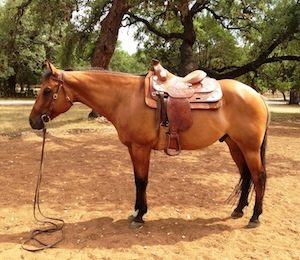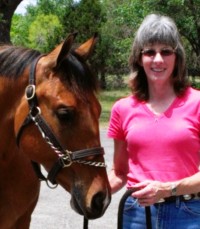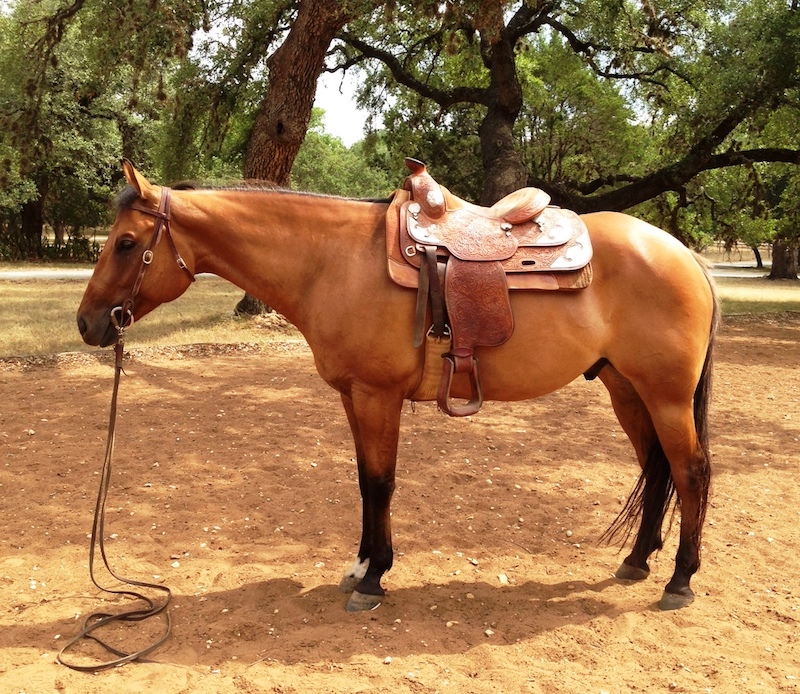Consistency and Time Will Train this Essential Aid
by Eleanor Blazer
 Whoa is the first verbal command a foal hears, and it will be repeated many times over the course of its lifetime. How well the horse responds to whoa depends on training and consistent reinforcement.
Whoa is the first verbal command a foal hears, and it will be repeated many times over the course of its lifetime. How well the horse responds to whoa depends on training and consistent reinforcement.
When teaching a horse to stop, the trainer needs to understand the definition of whoa. That definition is stop and do not move. This means no movement of the feet until the horse is given the next command or cue.
Every person who handles a horse is a trainer. Becoming distracted and allowing the horse to move teaches the horse it is permissible to cheat when executing the stop. This does the horse no favor—it only leads to confusion and lack of discipline. It sets up you and the horse for failure when stopping and standing still is necessary. So put down the cell phone and pay attention to your horse.
Horses learn what whoa means during leading lessons. Foals will only be able to stand still for a few seconds after stopping due to short attention spans. Keep daily lessons brief; working with the youngster for a few minutes every day will lay a good foundation. At this stage repetition and gentle reinforcement is the key. As the youngster matures, the length of time for standing still will increase.
Unfortunately, confrontation is a requirement for learning. There will be a time when you will need to confront the horse about not responding to the cue to stop, or not standing still after the stop.
Dr. Jennifer Williams, instructor for the course Understanding Equine Behavior at www.horsecoursesonline.com explains, “Reinforcement increases the likelihood of a response. But when reinforcements are no longer given, eventually your horse stops performing the behavior you’ve conditioned/trained. This is called extinction or extinguishing a behavior.” During training sessions properly executed stops and standing quietly should be reinforced by rewarding the horse with a verbal good boy, a few minutes of rest, or a pat on the neck.
The trainer must be prepared to use positive punishment when the trained horse cheats with a lazy stop or doesn’t remain standing still until the next cue is given. When handling the horse in-hand this can be a sharp jerk on the lead and backing a few steps. The use of a stud chain over the nose or under the jaw may have to be utilized for horses that don’t believe you mean business. Under saddle this could be backing a few steps after a lazy stop. Dr. Williams reminds her online students that no matter what reinforcement is used it must be implemented right after the behavior.
Eventually most young horses will advance to lunging as part of training. Reinforcing the stop when a horse is 25 feet away from you can be daunting.
All horses must know that whoa means stop and do not move before beginning lunging training. When asking the lunging horse to stop, say whoa and move your body to a position in front of the horse’s natural balance point. This blocks the horse’s forward movement and effectively brings him to a halt. If the horse doesn’t respond correctly, give the verbal command again, followed by a jerk on the line. (If you cannot get the horse’s attention, the physical cue is useless.) Repeat the verbal and physical commands as often as it takes until he understands the message and complies. Be sure you have moved to a position in front of the horse’s balance point when asking for the stop.
It may take three or four tries to get the horse to stop, but he’ll soon get it. Praise him when he does. Do not allow him to turn and face you; do not allow him to come into you. Walk to him and pet him on the head and neck, then go back to your original position and restart the horse at the walk. Repeat the stop command, and when he stops, praise him. Teach the stop at all three gaits and in both directions. Stopping the horse while under saddle will now be easier.
Teaching the horse to ground-tie is a great aid for reinforcing the whoa. When grooming or tacking-up remove the horse from the crossties and make him stand still as you move around him. If he moves, put him back in place and tell him whoa. In several days he will understand that he is not to move.
Allowing plenty of time to learn is the key to teaching stopping, as with other specific performances. Don’t rush the horse. Proper training, along with reinforcing the behavior, will result in the desired performance.
Copyright @ 2017
* Take the online courses “Understanding Equine Behavior” and “Training Performance Horses”. Earn certification or work toward a Bachelor of Science degree in Equine Studies. Go to www.horsecoursesonline.com for more information.
Originally Published September 2017 Issue

Eleanor Blazer was raised training and caring for horses. She learned to ride and care for the horses her family bought and sold. Many of these horses required improved nutrition when they arrived for training. Eleanor’s experience and research has benefited both horses and horse lovers in the field of equine nutrition. An equine nutrition consultant, based in Bulverde, Texas, she keeps busy doing equine nutrition consultations, conducting seminars, and speaking to youth groups about horse care and nutrition. Eleanor is the author of the syndicated column The Way of Horses. She has more than 20 years experience helping and being a mentor to those wanting to know how to provide the very best care and nutrition for our special friend – the horse.






